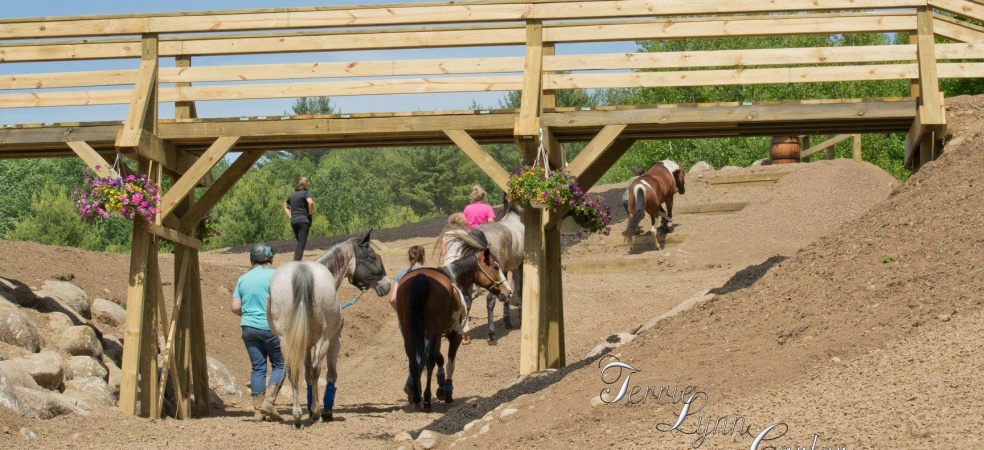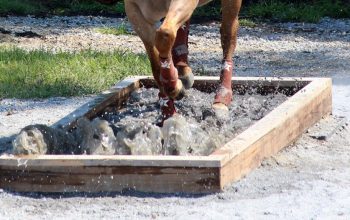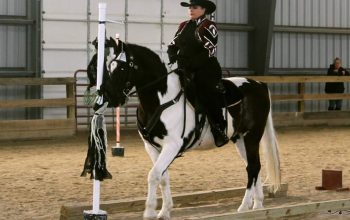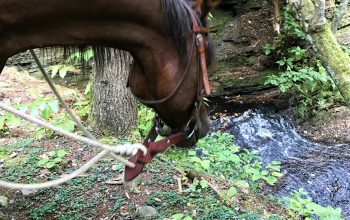 A Mountain Trail Course ® is fundamentally a trail course that serves two functions; it is a training tool incorporating proven techniques of Horsemanship and at the same time is aesthetically pleasing and complements the beauty of the surrounding landscape. Each Mountain Trail Course by Mark Bolender® has been described as “functional art”. They have a flow pattern designed to challenge the horse instead of intimidating it. The flow pattern also is uniquely designed and constructed to instruct and inspire the rider.
A Mountain Trail Course ® is fundamentally a trail course that serves two functions; it is a training tool incorporating proven techniques of Horsemanship and at the same time is aesthetically pleasing and complements the beauty of the surrounding landscape. Each Mountain Trail Course by Mark Bolender® has been described as “functional art”. They have a flow pattern designed to challenge the horse instead of intimidating it. The flow pattern also is uniquely designed and constructed to instruct and inspire the rider.
One thing most individuals love about a golf course is the beauty of the course itself. That is what I strive for in a Mountain Trail Course. I want the beauty with a practical application of form to function that allows me to enjoy the beauty while I build the boldness and confidence in the horse and rider. To some, a course that is pleasing to the eye is not a thing of concern but to others it is everything. The horse is a majestic noble elegant animal of great beauty and it is magnificent when the surroundings can enhance that beauty. Many of the cowboys of the past lived with that beauty on a daily basis and loved every minute of it. As you will see by the photos with a little thought one can mix logs, rocks and plants to create a pleasing natural looking affect in which to ride and train.
 Often the beauty hides the hazards and dangers that lie on the trail. Yet the dangers must be addressed in order to continue the journey. A proper course will have elements of all the obstacles that lie and are hidden on the mountain trails that take us close to where the eagles soar. A properly designed course is one that offers the beginner or the Olympic rider a challenge yet is safe when properly used.
Often the beauty hides the hazards and dangers that lie on the trail. Yet the dangers must be addressed in order to continue the journey. A proper course will have elements of all the obstacles that lie and are hidden on the mountain trails that take us close to where the eagles soar. A properly designed course is one that offers the beginner or the Olympic rider a challenge yet is safe when properly used.
Mountain Trail is an exciting and relatively new competitive equestrian sport. Negotiating difficult obstacles that might be found on a typical mountain trail alongside other competitors can be an exhilarating experience for the rider. For the spectators watching the competition it can be just as thrilling, as demonstrated by the growing number of enthusiasts in the sport. Like other equestrian sports, Mountain Trail requires special training. Horses will not naturally or easily descend a hill into a pond, then over a swinging bridge and through heavy logs and boulders. When done to perfection, the horse moves through the obstacles with boldness and confidence you just don’t see in other sports.
 The vast majority of the “Mountain Trail Courses” that I have built are built in six days. We make the impossible possible and here is how we do it. I have already googled the site and have an idea of what I want to do. I sent Salmon River Horse Park owners Barbara and John Bouck a list of needed equipment, gravel, how many truckloads of large rocks, number of required laborers and a material list for each obstacle laid out in a manner that they can get at least three bids for the lumber package. When I showed up in Altmar, New York near Syracuse, the required items were on hand. I had spent a little time the night before on the site, so I had a fair idea of what I wanted but knew it could change depending what was below the surface. We did hit some rock and found one water spring.
The vast majority of the “Mountain Trail Courses” that I have built are built in six days. We make the impossible possible and here is how we do it. I have already googled the site and have an idea of what I want to do. I sent Salmon River Horse Park owners Barbara and John Bouck a list of needed equipment, gravel, how many truckloads of large rocks, number of required laborers and a material list for each obstacle laid out in a manner that they can get at least three bids for the lumber package. When I showed up in Altmar, New York near Syracuse, the required items were on hand. I had spent a little time the night before on the site, so I had a fair idea of what I wanted but knew it could change depending what was below the surface. We did hit some rock and found one water spring.
The start date was on a Wednesday which meant that we would be required to work the weekend and finish on Monday for the clinic that was scheduled to start on Tuesday. Pressure was on. The contractor who provided the equipment and two operators were looking at me in disbelief when I shared my concept for the course and said we must be done in six days. The seven Amish carpenters were also shaking their heads and the owners had friends betting that it was impossible. The plans came out along with the tools and the obstacles began to take shape with seven hard working carpenters. The owner along with a couple of workers were cutting the lower limbs off the trees on site so I could get a better idea of the sites potential.
 Trails had to be made for the flow and pads needed to be fit in for the obstacles. I had the contractor start with pushing in the pond. This gave me time to get my mind around where to put the Trestle Bridge. In the end, I made a ravine for the bridge and in the process made it look like it should always be a ravine. I knew where I wanted the viewing stand and wanted to construct the course around this. The challenge was to have as many obstacles viewable from one point. Since I can operate most equipment I was changing from one piece of equipment to another as needed. At the end of day, a number of obstacles had taken shape, the pond outline was started, and many trees had been removed to open the site up.
Trails had to be made for the flow and pads needed to be fit in for the obstacles. I had the contractor start with pushing in the pond. This gave me time to get my mind around where to put the Trestle Bridge. In the end, I made a ravine for the bridge and in the process made it look like it should always be a ravine. I knew where I wanted the viewing stand and wanted to construct the course around this. The challenge was to have as many obstacles viewable from one point. Since I can operate most equipment I was changing from one piece of equipment to another as needed. At the end of day, a number of obstacles had taken shape, the pond outline was started, and many trees had been removed to open the site up.
 On day two, most obstacles were completed, and we were setting the trestle bridge uprights in the manmade ravine. The pond was ready for sand and the liner. By the end of day three all the obstacles had to be completed along with the pond. The pond required a liner with a grid and gravel over that. Since my Amish crew could not work on Sunday we had to have been 80% done by the end of Sunday with cleanup of minor details and miscellaneous scheduled for Monday. In order to keep on schedule 10-hour work days were required by the carpenters and 12-hour days by the equipment operators. When it was all done it was completed due to a team effort by the owners who never stopped bringing needed items for the equipment operators, carpenters and general labors and by the volunteers who prepared the meals. The 7 great Amish carpenters, a very competent equipment contractor, hardworking laborers and owners that were prepared allowed this course to be constructed in six days.
On day two, most obstacles were completed, and we were setting the trestle bridge uprights in the manmade ravine. The pond was ready for sand and the liner. By the end of day three all the obstacles had to be completed along with the pond. The pond required a liner with a grid and gravel over that. Since my Amish crew could not work on Sunday we had to have been 80% done by the end of Sunday with cleanup of minor details and miscellaneous scheduled for Monday. In order to keep on schedule 10-hour work days were required by the carpenters and 12-hour days by the equipment operators. When it was all done it was completed due to a team effort by the owners who never stopped bringing needed items for the equipment operators, carpenters and general labors and by the volunteers who prepared the meals. The 7 great Amish carpenters, a very competent equipment contractor, hardworking laborers and owners that were prepared allowed this course to be constructed in six days.

Good Horsemanship, good equitation and lots of fun are three good reasons that will continue to make this new sport grow.
Happy Trails and Bolender Blessings,
Mark Bolender
To learn more about Barbara and John Bouck and Salmon River Stables visit www.salmonriverstables.com




